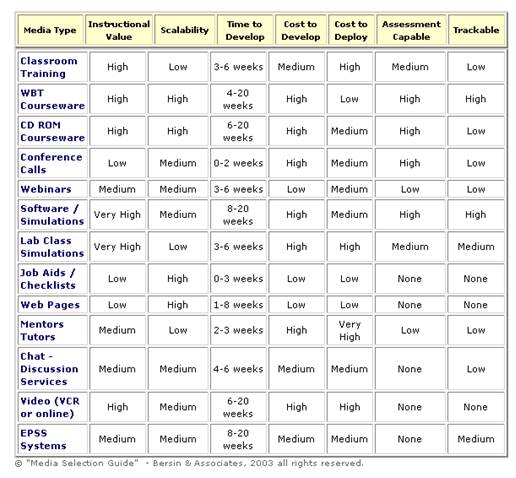
Planning Resources
What do we mean by resources?
There are different types of education delivery methods that are best suited to each piece of an educational product. Most times multiple types of educational delivery methods are used to support a clinical practice change or the learning of a skill. Using more that one type of educational tool is called Blended Learning. The type of tool that you choose may also be based on your resources.
What resources are available and needed at CHHS for successful education?
People
If the right people are not available or supported to work on the project, the project will not be successful.
Learning Specialists/Content Developers
Educational Services has staff that can develop many types of tools for education. They also have access to programs and templates to create many types of educational products, from facilitator guides to online learning modules.
Subject Matter Experts (SME)
This person has deep knowledge of the content and process. If multiple disciplines or roles will be affected by the change, a representative group must be assembled to assure that all groups needs are met. The SME must be able to regularly meet and provide content and case studies. They must also help to identify the target audience, the ones who need the training: the learning needs of that audience, and the outcomes that need to be achieved.
End Users
End User involvement is also essential in the building of good education. The content must be tested by End Users with different roles and levels of experience in order to make sure it meets the needs of the target audience.
Time
Education takes time to develop and is a factor that affects all stakeholders. Just as the communication around a topic or project must begin at the start of that project, the education plan must also begin at the start of the project.
Many times education hinges on the completion of pre-work by the group, like the updating of policies or guidelines. The group must work on these updates early on in order to support any practice change; but don’t make the mistake of thinking that all the kinks need to be worked out to begin working on the education. The basic plan and structure of education can be developed early on. System issues need to be addressed before the final implementation plan. Working through the case scenarios and educational pieces can help the group identify gaps in policy and systems that help the project move forward. Different types of educational pieces need different amounts of time to complete. A Just-in-Time (KIT) job aid can be completed in 1-7 days, and an online module can take several weeks or months to complete.
The basic plan and structure of education can be developed early on.
System issues need to be addressed before the final implementation plan.
Working through the case scenarios and educational pieces can help the group identify gaps in policy and systems that help the project move forward.
Different types of educational
pieces need different amounts of time to complete.
- Just-in-Time (JIT) job aid can be completed in 1-7 days, and an online
module can take several weeks or months to complete.
SMEs must have the time to develop content, get consensus, review and test content. A delay in content or the unavailability of a SME is the main reason that a project stalls.
Money
In these difficult times, it’s easy to see why the cost of any education is an important factor. There are material costs and the costs of the programs that are used to develop them, there are also the costs of the developers, SMEs, and end users time.
But for any large educational rollout the primary cost of an education is the amount of time it will take end users to go through the education. The indirect staff time to attend a class, or go through an online course costs thousands of dollars. There is also a cost for not developing training or for not coordinating training efforts. Some training can impact the costs of harm to patients, like the CVL care bundles. Some training helps care providers do their work more effectively and efficiently, saving thousands on the back end even though it could cost thousands on the front end.
Many proposals include information about the return on investment or ROI of a training program. This is a powerful method to show the value of the effort that you are going to make. In this case it would be important to identify the outcomes that you hope to achieve through the training and then measure those outcomes to evaluate those results.
What are the key principles in choosing a project based on resources available?
The following is a chart that shows the types of educational tools that are available and what their level of costs are.
